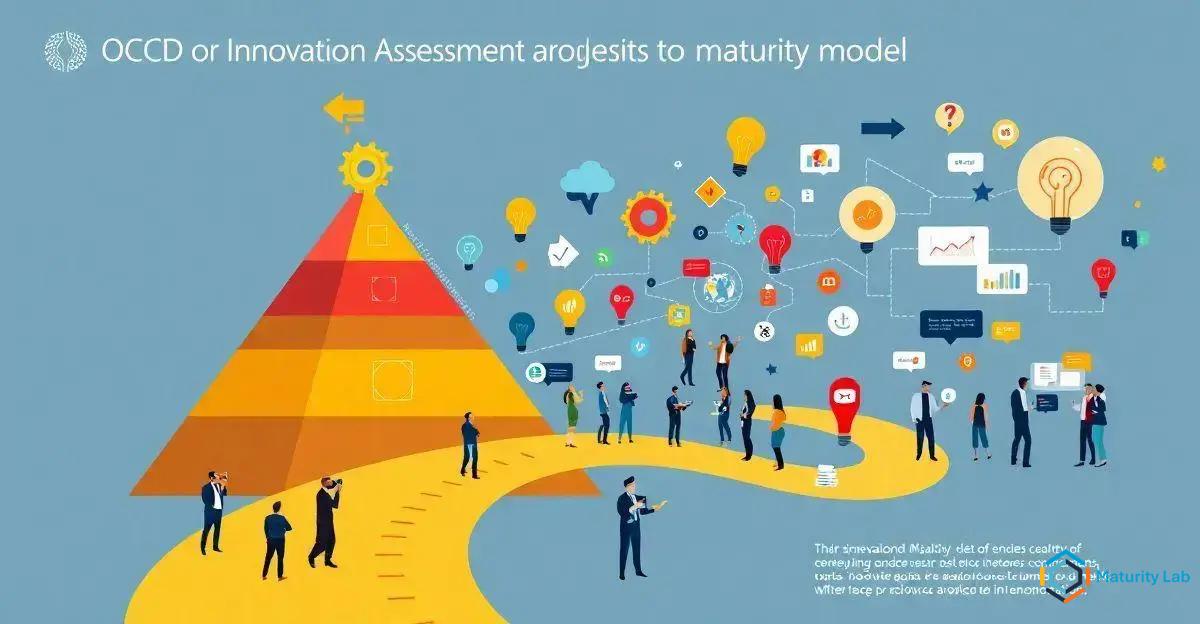The OECD Innovation Maturity Model is a strategic framework designed to help organizations assess and improve their innovation capabilities by focusing on leadership, resources, strategy, and culture. It involves conducting innovation assessments, identifying success indicators, and developing a strategic roadmap to integrate innovation into the organizational culture, ultimately driving sustainable growth and competitive advantage.
The OECD Innovation Maturity Model serves as a pivotal framework for organizations aiming to enhance their innovation capabilities. By leveraging this model, businesses can conduct a comprehensive innovation assessment to identify key success indicators. This process not only aids in understanding current innovation maturity levels but also guides strategic planning for future growth. With the increasing importance of innovation in today’s competitive landscape, the OECD model provides valuable insights into optimizing innovation processes and achieving sustainable success.
Understanding the OECD Innovation Maturity Model

The OECD Innovation Maturity Model is a comprehensive framework designed to evaluate and enhance the innovation capabilities of organizations. This model is particularly relevant in today’s fast-paced business environment, where innovation is a critical driver of competitive advantage and long-term success. By systematically assessing an organization’s innovation processes, the OECD model provides a structured approach to understanding and improving innovation maturity.
At its core, the OECD Innovation Maturity Model focuses on several key dimensions that are essential for fostering a culture of innovation. These dimensions include leadership commitment, resource allocation, strategic alignment, and the integration of innovation into the organizational culture. Each of these elements plays a crucial role in determining an organization’s ability to innovate effectively and sustainably.
Key Dimensions of the Model
Leadership commitment is fundamental to the success of any innovation initiative. Leaders must not only endorse innovation but also actively participate in creating an environment that encourages experimentation and risk-taking. This involves setting clear innovation goals, providing the necessary resources, and fostering a culture that values creativity and continuous improvement.
Resource allocation is another critical component of the OECD model. Organizations must ensure that they have the right mix of financial, human, and technological resources to support their innovation efforts. This includes investing in research and development, acquiring new technologies, and developing the skills and capabilities of employees to drive innovation forward.
Strategic alignment is also vital for successful innovation. The OECD model emphasizes the importance of aligning innovation activities with the organization’s overall strategic objectives. This ensures that innovation efforts are focused on areas that will deliver the most significant impact and contribute to the organization’s long-term goals.
Finally, integrating innovation into the organizational culture is essential for sustaining innovation over time. This involves creating an environment where employees are encouraged to share ideas, collaborate across departments, and learn from both successes and failures. By embedding innovation into the fabric of the organization, companies can create a continuous cycle of improvement and adaptation.
In summary, the OECD Innovation Maturity Model provides a robust framework for assessing and enhancing an organization’s innovation capabilities. By focusing on leadership commitment, resource allocation, strategic alignment, and cultural integration, organizations can systematically improve their innovation maturity and achieve sustainable success in today’s competitive business landscape.
Key Success Indicators in Innovation Assessment

Identifying key success indicators is a crucial step in conducting a thorough innovation assessment. These indicators serve as benchmarks that organizations can use to measure their innovation performance and guide strategic decision-making. The OECD Innovation Maturity Model highlights several success indicators that are instrumental in evaluating the effectiveness of innovation processes.
One of the primary success indicators is the rate of new product or service development. This metric reflects an organization’s ability to generate and bring new offerings to market. A high rate of development indicates a robust innovation pipeline and a proactive approach to meeting customer needs and market demands. Organizations should track the time it takes to move from ideation to commercialization, as this can provide insights into the efficiency of their innovation processes.
Another critical indicator is the level of employee engagement in innovation activities. Engaged employees are more likely to contribute creative ideas and participate actively in innovation initiatives. Organizations can measure engagement through surveys, participation rates in innovation programs, and the number of ideas generated by employees. High levels of engagement often correlate with a strong innovation culture and a supportive work environment.
Customer feedback and satisfaction
also serve as vital success indicators. By gathering and analyzing customer feedback, organizations can assess how well their innovations meet market needs and expectations. High customer satisfaction levels indicate that the organization is effectively addressing customer pain points and delivering value through its innovative offerings.
Financial performance metrics, such as revenue growth from new products or services, are essential indicators of innovation success. These metrics provide a direct link between innovation efforts and the organization’s bottom line. By tracking revenue contributions from new offerings, organizations can evaluate the financial impact of their innovation strategies and make informed investment decisions.
Finally, collaboration and partnerships are important success indicators in innovation assessment. The ability to collaborate with external partners, such as research institutions, startups, and industry peers, can significantly enhance an organization’s innovation capabilities. Organizations should assess the number and quality of their partnerships and the outcomes of collaborative innovation projects.
In conclusion, key success indicators in innovation assessment provide valuable insights into an organization’s innovation performance. By focusing on metrics such as the rate of new product development, employee engagement, customer satisfaction, financial performance, and collaboration, organizations can systematically evaluate and enhance their innovation processes, ultimately driving sustainable growth and competitive advantage.
Implementing the OECD Model for Business Growth

Implementing the OECD Innovation Maturity Model can be a transformative step for organizations seeking to enhance their innovation capabilities and drive business growth. This model provides a structured approach to assessing and improving innovation processes, enabling organizations to align their innovation efforts with strategic business objectives effectively.
The first step in implementing the OECD model is to conduct a comprehensive innovation assessment. This involves evaluating the current state of the organization’s innovation capabilities across key dimensions such as leadership, resources, strategy, and culture. By identifying strengths and areas for improvement, organizations can develop a clear understanding of their innovation maturity level and set realistic goals for advancement.
Once the assessment is complete, organizations should focus on developing a strategic innovation roadmap. This roadmap outlines the specific actions and initiatives required to enhance innovation capabilities and achieve desired business outcomes. It should include short-term and long-term goals, resource allocation plans, and key performance indicators to track progress. By aligning the innovation roadmap with the organization’s overall strategic objectives, businesses can ensure that their innovation efforts contribute directly to growth and competitiveness.
Leadership commitment is crucial for the successful implementation of the OECD model. Leaders must champion innovation initiatives, allocate necessary resources, and create an environment that encourages creativity and experimentation. This includes providing training and development opportunities for employees, fostering cross-functional collaboration, and recognizing and rewarding innovative contributions.
Another critical aspect of implementation is integrating innovation into the organizational culture. This involves embedding innovation into everyday practices and encouraging employees at all levels to participate in innovation activities. Organizations can achieve this by establishing innovation teams, promoting open communication, and creating platforms for idea sharing and collaboration. By cultivating a culture that values innovation, organizations can sustain their innovation efforts and continuously adapt to changing market conditions.
Finally, organizations should focus on measuring and refining their innovation processes. Regularly reviewing performance against key success indicators allows organizations to identify areas for improvement and make data-driven decisions. This iterative approach ensures that innovation efforts remain aligned with business goals and continue to deliver value over time.
In summary, implementing the OECD Innovation Maturity Model for business growth involves conducting a thorough innovation assessment, developing a strategic roadmap, securing leadership commitment, integrating innovation into the culture, and continuously measuring and refining processes. By following these steps, organizations can enhance their innovation capabilities, drive sustainable growth, and maintain a competitive edge in today’s dynamic business environment.
In conclusion, the OECD Innovation Maturity Model serves as a pivotal framework for organizations striving to enhance their innovation capabilities and achieve sustainable business growth.
By understanding the intricacies of this model, businesses can conduct thorough innovation assessments, identifying key success indicators that guide strategic decision-making.
The model emphasizes the importance of leadership commitment, resource allocation, strategic alignment, and cultural integration, all of which are essential for fostering a robust innovation environment.
Implementing the OECD Model
Implementing the OECD model requires a structured approach, beginning with a comprehensive evaluation of current innovation processes.
Developing a strategic innovation roadmap ensures that efforts are aligned with organizational objectives, while leadership plays a critical role in championing innovation initiatives.
By embedding innovation into the organizational culture and continuously measuring performance against success indicators, companies can create a dynamic and adaptive innovation ecosystem.
Ultimately, the OECD Innovation Maturity Model provides organizations with the tools and insights needed to navigate the complexities of innovation in today’s competitive landscape.
By leveraging this model, businesses can enhance their innovation maturity, drive growth, and maintain a competitive edge, ensuring long-term success and resilience in an ever-evolving market.
Frequently Asked Questions about the OECD Innovation Maturity Model
What is the OECD Innovation Maturity Model?
The OECD Innovation Maturity Model is a framework designed to evaluate and enhance an organization’s innovation capabilities by assessing key dimensions such as leadership, resources, strategy, and culture.
How does the OECD model help in innovation assessment?
The model provides a structured approach to identifying key success indicators, enabling organizations to measure their innovation performance and guide strategic decision-making effectively.
What are some key success indicators in innovation assessment?
Key success indicators include the rate of new product development, employee engagement in innovation activities, customer satisfaction, financial performance, and collaboration with external partners.
How can organizations implement the OECD model for business growth?
Organizations can implement the model by conducting a comprehensive innovation assessment, developing a strategic innovation roadmap, securing leadership commitment, integrating innovation into the culture, and continuously measuring and refining processes.
Why is leadership commitment important in the OECD model?
Leadership commitment is crucial as it involves championing innovation initiatives, allocating necessary resources, and creating an environment that encourages creativity and experimentation.
How does the OECD model contribute to long-term business success?
By enhancing innovation maturity, aligning efforts with strategic objectives, and fostering a culture of innovation, the OECD model helps organizations drive sustainable growth and maintain a competitive edge in the market.

